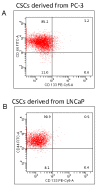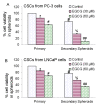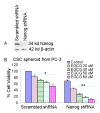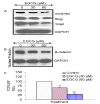The dietary bioflavonoid quercetin synergizes with epigallocathechin gallate (EGCG) to inhibit prostate cancer stem cell characteristics, invasion, migration and epithelial-mesenchymal transition
- PMID: 20718984
- PMCID: PMC2933702
- DOI: 10.1186/1750-2187-5-14
The dietary bioflavonoid quercetin synergizes with epigallocathechin gallate (EGCG) to inhibit prostate cancer stem cell characteristics, invasion, migration and epithelial-mesenchymal transition
Abstract
Background: Much attention has been recently focused on the role of cancer stem cells (CSCs) in the initiation and progression of solid malignancies. Since CSCs are able to proliferate and self-renew extensively due to their ability to express anti-apoptotic and drug resistant proteins, thus sustaining tumor growth. Therefore, the strategy to eradicate CSCs might have significant clinical implications. The objectives of this study were to examine the molecular mechanisms by which epigallocathechin gallate (EGCG) inhibits stem cell characteristics of prostate CSCs, and synergizes with quercetin, a major polyphenol and flavonoid commonly detected in many fruits and vegetables.
Results: Our data indicate that human prostate cancer cell lines contain a small population of CD44+CD133+ cancer stem cells and their self-renewal capacity is inhibited by EGCG. Furthermore, EGCG inhibits the self-renewal capacity of CD44+alpha2beta1+CD133+ CSCs isolated from human primary prostate tumors, as measured by spheroid formation in suspension. EGCG induces apoptosis by activating capase-3/7 and inhibiting the expression of Bcl-2, survivin and XIAP in CSCs. Furthermore, EGCG inhibits epithelial-mesenchymal transition by inhibiting the expression of vimentin, slug, snail and nuclear beta-catenin, and the activity of LEF-1/TCF responsive reporter, and also retards CSC's migration and invasion, suggesting the blockade of signaling involved in early metastasis. Interestingly, quercetin synergizes with EGCG in inhibiting the self-renewal properties of prostate CSCs, inducing apoptosis, and blocking CSC's migration and invasion. These data suggest that EGCG either alone or in combination with quercetin can eliminate cancer stem cell-characteristics.
Conclusion: Since carcinogenesis is a complex process, combination of bioactive dietary agents with complementary activities will be beneficial for prostate cancer prevention and/ortreatment.
Figures







Similar articles
-
Inhibition of sonic hedgehog pathway and pluripotency maintaining factors regulate human pancreatic cancer stem cell characteristics.Int J Cancer. 2012 Jul 1;131(1):30-40. doi: 10.1002/ijc.26323. Epub 2011 Aug 25. Int J Cancer. 2012. PMID: 21796625 Free PMC article.
-
Resveratrol inhibits pancreatic cancer stem cell characteristics in human and KrasG12D transgenic mice by inhibiting pluripotency maintaining factors and epithelial-mesenchymal transition.PLoS One. 2011 Jan 31;6(1):e16530. doi: 10.1371/journal.pone.0016530. PLoS One. 2011. PMID: 21304978 Free PMC article.
-
Sulforaphane synergizes with quercetin to inhibit self-renewal capacity of pancreatic cancer stem cells.Front Biosci (Elite Ed). 2011 Jan 1;3(2):515-28. doi: 10.2741/e266. Front Biosci (Elite Ed). 2011. PMID: 21196331 Free PMC article.
-
Human cancer stem cells are a target for cancer prevention using (-)-epigallocatechin gallate.J Cancer Res Clin Oncol. 2017 Dec;143(12):2401-2412. doi: 10.1007/s00432-017-2515-2. Epub 2017 Sep 23. J Cancer Res Clin Oncol. 2017. PMID: 28942499 Free PMC article. Review.
-
The Potential of Epigallocatechin Gallate in Targeting Cancer Stem Cells: A Comprehensive Review.Curr Med Chem. 2024;31(32):5255-5280. doi: 10.2174/0109298673281666231227053726. Curr Med Chem. 2024. PMID: 38243984 Review.
Cited by
-
Targeting Cancer Stem Cells by Dietary Agents: An Important Therapeutic Strategy against Human Malignancies.Int J Mol Sci. 2021 Oct 28;22(21):11669. doi: 10.3390/ijms222111669. Int J Mol Sci. 2021. PMID: 34769099 Free PMC article. Review.
-
EGCG inhibits properties of glioma stem-like cells and synergizes with temozolomide through downregulation of P-glycoprotein inhibition.J Neurooncol. 2015 Jan;121(1):41-52. doi: 10.1007/s11060-014-1604-1. Epub 2014 Aug 31. J Neurooncol. 2015. PMID: 25173233
-
Anticancer Potential of Natural Bark Products-A Review.Plants (Basel). 2021 Sep 13;10(9):1895. doi: 10.3390/plants10091895. Plants (Basel). 2021. PMID: 34579427 Free PMC article. Review.
-
The Role of Natural Flavonoids as Telomerase Inhibitors in Suppressing Cancer Growth.Pharmaceuticals (Basel). 2023 Apr 17;16(4):605. doi: 10.3390/ph16040605. Pharmaceuticals (Basel). 2023. PMID: 37111362 Free PMC article. Review.
-
Telomerase Inhibitors from Natural Products and Their Anticancer Potential.Int J Mol Sci. 2017 Dec 21;19(1):13. doi: 10.3390/ijms19010013. Int J Mol Sci. 2017. PMID: 29267203 Free PMC article. Review.
References
-
- American. Cancer Society Cancer Statistics. 2009.
-
- Institute NC. Defeating prostate cancer: Crucial directions for research. Report of the Prostate Cancer Progress Review Group. 1998. - PubMed
LinkOut - more resources
Full Text Sources
Other Literature Sources
Research Materials
Miscellaneous

